Europe tours for over 50s & 60s
_(1).jpg?branch=prd&width=75&quality=35&blur=1&format=pjpg&auto=webp)
We think traveling’s like a fine Italian Nebbiolo: it gets better with age
You know what you like, you savor the small things, and you may have more freedom to jet off for a trip around Europe. With diverse cultures, gorgeous landscapes and lip-smacking food, Europe has it all, and our trips are for folks of all ages and backgrounds who share a passion for travel.
How about cycling the picturesque countryside of Provence or exploring the coffee-scented streets of Sicily ? Or discovering lochs and local legends in the Scottish Highlands ? With a legendary local leader to handle the logistics, ready-made friends to explore with and plenty of authentic experiences, you can focus on chatting with the locals and choosing which pastry to order for breakfast—you know, the important stuff.
Our Premium trips feature our best accommodation, most comfortable transport and exclusive experiences led by our most experienced leaders.
Designed for those who want more inclusions, our Comfort trips offer a higher standard of accommodation, larger vehicles and more included activities.
The classic Intrepid style. Our Original trips include some activities and stay at more hotels than Basix trips—an ideal choice for those who want a taste of everything.
For travelers on a budget, our Basix trips keep inclusions to a minimum. They’re about value and lots of free time to choose the activities and extras that you want to do.
It's all well and good sticking to the tourist trail, but anyone can Google that. We work exclusively with local leaders – because who better to show you the soul of a destination than someone who lives and breathes the culture? With insider knowledge of hidden hangouts, local legends and, most importantly, the dishes you won't find on the tourist menu, you'll go behind the scenes for a deeper, more culturally-rich experience.
Travelling solo is fun, but we think it's even better with a small group of like-minded travellers just as eager to explore as you are. Our trips are for people of all ages and from all walks of life, from the rookie backpacker straight out of uni to retirees on a mission to tick off everything on their bucket lists. The diversity keeps things interesting – not to mention the new perspectives to uncover, stories to share and friendships to forge.
Travelling to a new place is exciting, but it can also be daunting. There's an itinerary to plan, accommodation to book and logistics to navigate – not to mention language barriers and border crossings. We're sure you could handle any situation, but it's reassuring to rock up and know that everything's been taken care of. Your leader will also keep you clued up on cultural do's and don'ts and help you avoid tourist traps so you can sit back and enjoy the ride.
Whether it's for finger-lickin' food, the freedom of the mountains or rare wildlife encounters, people travel for different reasons. That’s why we’ve created a range of travel themes and styles . From our Basix style with simple accommodation and plenty of free time to our Premium trips featuring our best stays, experiences and leaders (with our Original and Comfort styles in between), there's something to suit every Intrepid traveller.
Filter by rating
Scotland's Orkney Islands
Rome to Amalfi
Montenegro Sailing Adventure from Dubrovnik
Mainland Greece Discovery

Who are Intrepid travelers?
Intrepid travelers are connected more by attitude than age. They’re a friendly, open-minded and curious bunch, and many elect to travel solo. Our small groups are a mix of genders and ages between 18 and 70, with like-minded travelers from all over the world.
Are there age restrictions on your trips?
For the majority of our trips (excluding family trips), the minimum age for travelers is 15. An adult must accompany all children under 18.
Our overland trips have a minimum age of 18.
Kiddos younger than 15 can join us on our family trips and Short Break Adventures , but make sure to check each trip for its minimum age.
Most trips don’t have a maximum age limit, but a self-assessment form is required for all travelers 70 years and over.
How many people will be on my trip?
Good things come in small packages, which is why we keep our group sizes to a minimum. Small groups allow us to remain flexible with itineraries, use public transportation wherever we can and visit communities without intimidating the locals.
Most Intrepid trips run with an intimate group of 12-16 travelers, though they usually average around 10 people.
Our overland trips use purpose-built vehicles that can carry up to 24 travelers. Group sizes are displayed in the description of each trip.
Is it okay that I'm travelling alone?
Absolutely! The beauty of the Intrepid style of travel is that many of our travelers join because they are traveling solo and want to meet and share experiences with like-minded people.
Learn more about solo travel
I have a disability – can I join an Intrepid trip?
Intrepid is committed to making travel widely accessible, regardless of ability or disability. Please carefully consider whether you are physically and mentally able to complete the itinerary you have chosen, recognizing that on many trips, you will be required to carry your own bags and use public transport.
Where we can, we will make reasonable adjustments to the operation of our trips to facilitate the requirements of disabled travelers – such as booking ground floor accommodation or having our leaders communicate important directions in writing as well as verbally. Many travelers with disabilities have been able to enjoy our trips by traveling with a friend or companion who can assist with specific needs. If joining a group trip is not practical, we may be able to provide you with a private departure. Please contact us for further information on any of our itineraries.
Learn more about accessible travel with Intrepid
Do I need to buy travel insurance?
Travel insurance is compulsory on all our trips if you’re traveling internationally. We require that at a minimum you are covered for medical expenses including emergency repatriation, but minimum coverage may differ from trip to trip, so make sure you check the Travel Insurance section in your Essential Trip Information. You will not be permitted to join the group until your leader has sighted your insurance policy number and the insurance company's 24-hour emergency contact number – it’s really important there are no barriers to getting emergency assistance for you.
For travelers who reside within the European Union, Switzerland or the USA, the requirement to purchase travel insurance cannot be compulsory. However, the purchase of travel insurance is still highly recommended, and travelers from these regions who decline travel insurance when traveling outside their home region must sign a Travel Insurance Waiver Form at the Group Meeting, recognizing personal responsibility for emergency medical and repatriation costs should they arise.
Will I have my own room?
It's your call. Rooming on our trips is organized on a twin-share basis, but most of our trips also have the option to pay an extra fee for your own room. Just let us know at the time of booking and we'll arrange it for you.
For twin-share rooms, we pair up solo travellers with another traveller of the same gender as per the gender marker on each of their passports. As a responsible tour operator, we strive to create a safe and inclusive environment for everyone. In the case that your gender identity differs from what's indicated on your passport, please contact us so that we can discuss rooming options with you.
On a small selection of itineraries some accommodations are booked on an open-gender, multi-share basis. In those instances it will clearly be stated in your Essential Trip Information.
How does group time work?
Whether you’re traveling alone or with a partner, our trips have a set itinerary. But within that there’s time set aside for your own exploration (if you want to – no pressure). Depending on how you're feeling, you may want to have some downtime, ask your guide for a few tips then head out alone, or hang out with the group and see where the day takes you.
10 must-see places when you visit Georgia
How to visit Europe in the off-season
Best places to travel in May
Best places to travel in April
Best places to travel in June
Best places to travel in July
Best places to travel in October
Best places to travel in September

Watch our videos
259,000 subscribers

Join the conversation
134,000 followers

Pin our posts
25,600 followers

Get our newsletter
95140 subscribers
- Hearing-Aids
- Healthy Aging
- Losing Weight
- Medical Issues
- Reducing Stress
- Brain Health
- Solo Travel
- Travel Tips
- Small Business
- Part-time Jobs
- Encore Careers
- Managing Money
- End of Life Planning
- Retirement Tips
- Senior Living
- Journal Writing
- Inspiration
- Empowerment
- Getting Older
- Reinvention
- Giving Back
- Dating Advice
- Online Dating
- Adult Children
- Grandchildren
- Estrangement
- Arts and Crafts
- Piano Lessons
- Photography
- Entertainment

7 Best European Tours for Singles Over 50
Are you dreaming of a European adventure? Imagine sipping wine in Italy or enjoying train travel through the UK. Joining a tour can take care of all the logistics, allowing you to relax and travel with like-minded people.
Experience the best of Europe without the stress of planning every detail, ensuring a seamless and enjoyable trip. Whether it’s exploring historic cities, savoring local cuisine, or simply enjoying the scenic views, a tour can make your dream vacation a reality.
These European travel tours cater to the needs and preferences of mature solo travelers, offering a perfect blend of adventure and camaraderie.
- European Whirl – Go on a European whirlwind adventure, exploring London, Rome, Florence, Paris, Amsterdam, Heidelberg, Munich, Innsbruck, Venice, and Lucerne. Enjoy the convenience of expert travel guides, luxury transportation, and comfortable hotels while visiting iconic landmarks.
- London to Istanbul Rail Adventure – Embark on a memorable rail adventure through Central Europe, exploring iconic cities like Venice, Zagreb, Belgrade, and Sofia. Delve into off-the-beaten-path destinations in Croatia, Serbia, and Bulgaria with impressive train journeys and cultural discoveries along the way, including stays in enchanting Venice and historical Istanbul.
- The Great Adventure – Join The Great Adventure Tour and explore iconic European cities, from Rome and Florence to Venice, Zurich, Paris, London, Amsterdam, and more, immersing yourself in cultural wonders, stunning landscapes, and historic landmarks for a remarkable 14-day journey.
- Best of the Balkans: From Medieval Fortresses to the Majestic Adriatic Sea – Experience Road Scholar’s Best of the Balkans tour, a captivating 17-day journey through historically rich destinations in the Western Balkans, from medieval fortresses to the majestic Adriatic Sea, with expert-led discussions, cultural immersion, and unforgettable experiences.
- Best of Europe – Experience this 22-day European tour to explore iconic cities like Paris, Rome, Amsterdam, and Vienna, with guided tours, free days for independent exploration, and memorable experiences, including tasting champagne in France and cruising the canals in Amsterdam.
- Explore Central Europe – Join a National Geographic Journeys tour through Central Europe, exploring iconic landmarks, delving into the past with local historians, savoring culinary specialties, and experiencing the vibrant atmosphere of Berlin, Vienna, Prague, Budapest, and the Bohemian countryside.
- The Best of Eastern Europe – This tour provides a mix of guided sightseeing and free time, ensuring a balanced experience of cultural immersion and personal exploration.
Whether you dream of wandering through historic cobblestone streets, savoring delectable cuisines, or simply basking in the beauty of iconic landmarks, these European tours ensure an enriching and hassle-free experience.
Why Choose a Travel Tour in Europe
Choosing Europe as the destination for solo travelers over 50 offers a long list of compelling reasons that make it an ideal choice for mature solo travelers.
Rich History and Cultural Diversity
Europe boasts an extraordinary history that spans millenniums, leaving behind a wealth of historical landmarks, museums, and architectural marvels. From the grandeur of Rome’s Colosseum to the fairy-tale castles of Germany and the iconic cathedrals of France, Europe is a treasure trove of cultural heritage waiting to be explored.
Scenic Landscapes
The continent holds breathtaking landscapes that range from the rugged coastlines of Portugal to the pristine alpine peaks of Switzerland. Whether it’s the picturesque vineyards of Tuscany or the captivating fjords of Norway, Europe’s natural beauty captivates all of the senses.
Convenient Travel Infrastructure
Europe offers a well-developed and efficient transportation network, making it easy to navigate and explore multiple countries in a relatively short period. Trains, buses, and flights connect cities and regions, allowing travelers to customize their itineraries seamlessly.
Diverse Culinary Delights
Food enthusiasts will delight in Europe’s gastronomic offerings. Each country boasts a unique culinary identity, offering a delectable array of dishes and local delicacies to tantalize the taste buds.
Vibrant Arts and Entertainment
Whether it’s attending a world-class opera performance in Vienna, exploring contemporary art galleries in Paris, or witnessing the flamenco dance in Spain Europe’s artistic offerings provide an enriching cultural experience.
Welcoming and Inclusive Atmosphere
Europe is renowned for its hospitality and openness to visitors from all walks of life. Solo travelers will find a warm and friendly atmosphere, making it easy to meet like-minded people and forge new friendships. Many European countries are also known for their safety, making it an inviting destination for solo female travelers.
Europe’s combination of historical charm, natural beauty, diverse cultures, and traveler-friendly infrastructure makes it an irresistible multi-day tour destination for solo travelers over 50 seeking a rich and fulfilling experience.
Read 10 SAFEST CITIES TO TRAVEL AS A WOMAN OVER 50 .
European Tours for Mature Singles
European whirl.

Go on a captivating journey through the heart of Europe, immersing yourself in the rich history and culture of iconic cities with the guidance of expert local specialists. Uncover the secrets of London, Rome, Florence, and Paris as you visit historic landmarks like St. Peter’s Basilica and experience the allure of the Eiffel Tower and Notre Dame Cathedral.
Next, explore the enchanting cities of Amsterdam, Heidelberg, Munich, Innsbruck, Venice, and Lucerne. Witness the art of glassblowing in Venice and the architectural marvels of Amsterdam’s canals, the Golden Roof in Innsbruck, and St. Mark’s Square in Venice.
During your journey, indulge in the comforts of comfortable hotels, with all porterage, restaurant gratuities, and local taxes taken care of. Daily breakfast and up to half of your evening meals are included, ensuring a delightful culinary experience throughout.
Travel in style with luxury air-conditioned coaches equipped with Wi-Fi or alternative transportation like rail voyages. High-speed Eurostar trains add a touch of convenience as you journey from London to Brussels and back.
With the services of a Trafalgar Local Host and ample free time, you’ll have the freedom to explore at your own pace. Optional Experiences and surprise extras promise special memories, making this an exceptional adventure through Europe’s most captivating destinations.
Tour Operator: Trafalgar
Total Tour days: 14 days, 9 countries, 14 cities
Maximum Group: NA
London to Istanbul Rail Adventure

Experience the thrill of a rail adventure, traversing the heart of Central Europe, where iconic cities like Venice, Zagreb, Belgrade, and Sofia await your exploration. But this journey is more than just a conventional tourist route; it takes you off the beaten path to lesser-known destinations in Croatia, Serbia, and Bulgaria, offering a unique and authentic experience.
Travel by train, immersing yourself in the rich history and picturesque landscapes. Take a memorable ride on a historic narrow gauge train through the rugged Serbian mountains, and witness the diverse landscapes transform as you cross Bulgaria and reach Turkey.
Venture into the fascinating rural Balkans, going beyond the tourist haunts to discover the warmth of local hospitality. Visit a traditional winery in Serbia, where generations of winemakers have honed their craft, and explore the baroque town of Varazdin in Croatia, with its stunning architecture and captivating charm. Plovdiv city in Bulgaria , with its many archeological treasures will inspire you to visit again.
Throughout this epic rail adventure, you’ll witness the captivating blend of ancient traditions and modern dynamics that define Central and South-Eastern Europe. From the well-known landmarks to the hidden treasures, every moment of this trip promises to be an unforgettable experience.
Tour Operator: Explore
Total Tour days: 15 days
Maximum Group: 16
The Great Adventure
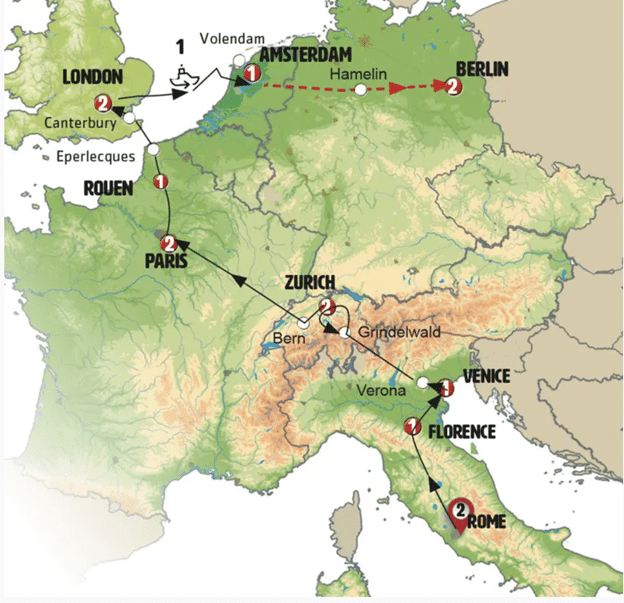
Embark on The Great Adventure Tour where you’ll enjoy an exhilarating 14-day journey through some of Europe’s most iconic and enchanting cities. Explore the Eternal City’s famous landmarks in Rome, including St. Peter’s Basilica and the Imperial Forums. Delight in the artistic heritage of Florence and its beautiful architecture before reaching the magical city of Venice, where you can experience a boat ride on the canals and witness the art of crafting Murano Glass.
Venture into the heart of the Alps, visiting Innsbruck and Zurich, with breathtaking alpine scenery, lakes, and snow-peaked mountains. Discover the stunning Swiss cities of Grindelwald and Lucerne, immersing yourself in the beauty of the Swiss landscape.
Experience the romance of Paris, marvel at iconic landmarks like the Eiffel Tower, and embark on a boat cruise along the Seine River. Explore the historic sites of London, including Buckingham Palace and the Tower of London, before crossing the English Channel into the Netherlands to discover Amsterdam and the picturesque village of Volendam.
Throughout this adventure, you’ll enjoy guided tours, scenic drives, and optional outings to make the most of your European experience. The Great Adventure Tour promises an amazing blend of culture, history, and natural beauty, creating memories that will last a lifetime.
Tour Operator: Euromundo
Total Tour days: 14 days
Best of the Balkans: From Medieval Fortresses to the Majestic Adriatic Sea
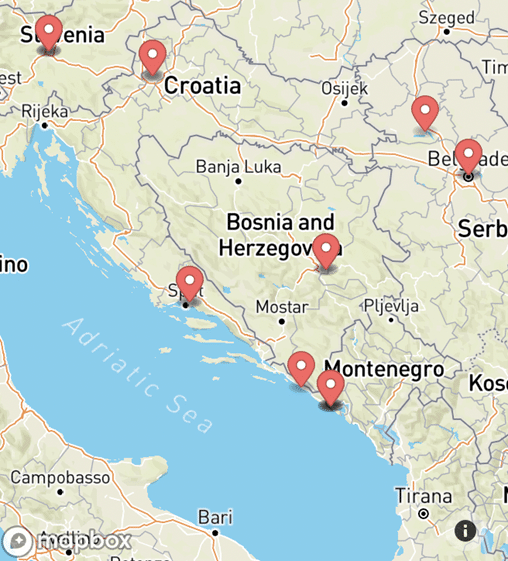
The Best of the Balkans: From Medieval Fortresses to the Majestic Adriatic Sea tour from Road Scholar is an enriching and captivating journey through the diverse and historically rich West Balkan region. From exploring medieval fortresses and UNESCO World Heritage sites to basking in the beauty of the Adriatic Sea, this 14-day tour offers a unique blend of cultural discovery, natural wonders, and immersive learning experiences.
You will have the opportunity to visit iconic destinations such as Dubrovnik, Kotor, and Mostar, each brimming with history and cultural significance. You’ll stroll through ancient cobblestone streets, witness sensational landscapes, and interact with locals, gaining insights into the region’s fascinating past and vibrant present.
The tour features expert-led discussions, engaging lectures, and interactive activities, providing a deeper understanding of the West Balkan’s complex history and the region’s geopolitical significance. From the medieval city walls of Dubrovnik to the ethereal beauty of Plitvice Lakes National Park, each stop on the itinerary promises a memorable and educational experience.
You will also have the chance to savor the local cuisine, sample traditional dishes, and enjoy the warm hospitality of the West Balkan people. This carefully curated journey promises an indelible adventure, fostering lifelong memories and a deeper appreciation for the diverse cultures and landscapes of the West Balkans.
Tour Operator: Road Scholar
Total Tour days: 17 days
Maximum Group: 24
Best of Europe

Indulge in one of our finest European tours, spanning 22 incredible days to explore the highlights of Western, Central, and Eastern Europe.
This jam-packed itinerary showcases iconic cities like Paris, Rome, Amsterdam, Venice, Berlin, Florence, and Luxembourg. Journey eastward to Budapest, Vienna, Prague, and Zagreb, with leisurely free days to discover places like Paris, Lucerne, Rome, Berlin, and Amsterdam at your own pace.
Marvel at the Neuschwanstein Castle in Germany and the Leaning Tower of Pisa in Italy, while local guides lead you through the charm and history of Rome, Budapest, Vienna, and Prague.
Savor the taste of champagne in France and cruise the charming canals of Amsterdam. This European vacation promises unforgettable moments, cultural experiences, and the exploration of captivating cities.
Tour Operator: Expat Explore
Total Tour days: 21 days
Explore Central Europe

Experience the cultural wonders of Central Europe on a National Geographic Journeys tour, delving into the most celebrated landmarks, from Germany’s Brandenburg Gate to Czechia’s Charles Bridge, while stepping into the past in Berlin, Vienna, Prague, Budapest, and the Bohemian countryside. All this led by local historians exploring ancient castles and historic districts, savoring culinary specialties, discovering contemporary art, and immersing in the ever-evolving vibrancy of these storied places.
Join this unique journey to explore sections of the Berlin Wall, Prague’s old town, taste the world-famous Sacher Torte in Vienna, and visit bustling markets with a foodie-guide.
Tour Operator: National Geographic Journeys in collaboration with G Adventures
Total Tour days: 9 days
The Best of Eastern Europe
Tour Operator: Globus
The Best of Eastern Europe tour by Globus is a 14-day journey through some of Eastern Europe’s most captivating cities.
Starting in Berlin, the tour includes stops in Warsaw, Krakow, Budapest, Vienna, and Prague. Highlights include visiting historical sites such as Auschwitz, exploring the vibrant culture of Budapest, and enjoying the beauty of Prague’s Old Town.
The tour provides a mix of guided sightseeing and free time, ensuring a balanced experience of cultural immersion and personal exploration.
Margaret’s Favorite European Destination
Margaret Manning, founder of Sixty & Me , tells about one of her favorite places in Europe.
In our article, 6 Amazing Adventure Tours for Women Like Us , we said that a sense of adventure does not diminish with age. As older women, we have a greater sense of self, are more confident and appreciate those things that are most important in life.
One of my favorite places to visit is Ireland. Here are a few of my favorite pictures of Southern Ireland’s Dingle Peninsula.
Sunlight breaking through the clouds on the Dingle Peninsula in Ireland.
Cill Mhuire Castle on the Dingle Peninsula in Ireland.
A small fishing village on the Dingle Peninsula in Ireland.
A baby sheep in a field on the Dingle Peninsula in Ireland.
Mountain lake on the Dingle Peninsula in Ireland.
Read 5 SECRETS TO HAVING A GREAT TRIP TO EUROPE IN YOUR 60S .
Let’s Have a Conversation:
Will you be traveling to Europe? Are you planning on joining a tour? Which destinations are new to you? Which have you heard of before? Share your experiences and comments below.
Embarking on a journey through Europe is like stepping into a living canvas, where history, culture, and breathtaking landscapes intertwine. From the iconic landmarks of Paris to the enchanting canals of Venice, every cobblestone street and charming village tells a story of centuries past. The diversity of languages, cuisines, and traditions creates a kaleidoscope of experiences, offering a taste of the old world and the new. Whether wandering through the vibrant markets of Barcelona, savoring a gelato in Rome, or marveling at the architectural wonders of Prague, each moment is a chapter in a travel diary that promises memories to last a lifetime. Europe , with its rich tapestry of heritage and modernity, is an enchanting adventure waiting to be explored.”
Tags Solo Travel
Sandra Roussy
Sandra is the middle-aged woman you hear about who sheds everything she owns and sets out into the world to rediscover and redefine herself. After more than twenty years spent in the fashion industry designing collections for brands such as La Senza, Victoria’s Secret, and JACOB Lingerie, she shifted her path and pursued her longtime passion for writing, traveling, and photography. Sandra was published in the NY Times best selling book Eat Pray Love Made Me Do It. A deeply personal essay hand-picked by Elizabeth Gilbert about loss, facing fears, and going after dreams. Visit her website: www.sandraroussy.com
You Might Also Like

A Tailored Getaway for Single Women 60+ in Mineral Wells, TX

7 Nifty Ideas to Help Any Progressive Older Woman Pack the Right Colours for Light Travel
print this page Print this page
Grand tour of Europe
For the senior couple or mature solo traveler seeking a small group educational tour focussed on exploring and learning with like minded people in Europe .
From $32,804 USD
Departing Apr, Aug
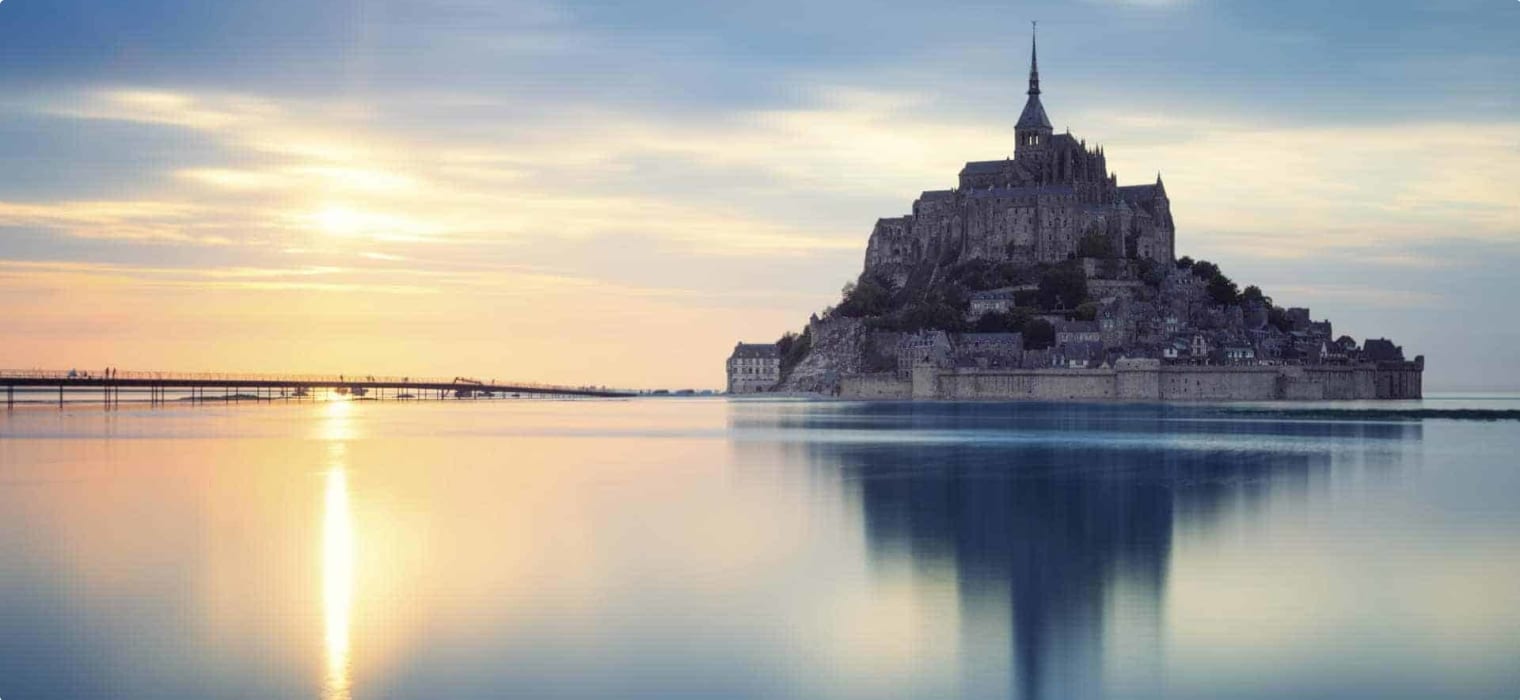
- 1. Explore Italy's and Spain's beautiful mediterranean coastline
- 2. Walk around the historic city of Lisbon
- 3. Learn about the importance of trade in Brugge
- Departure Dates
Small Group Grand tour of leading European countries.
Are you looking for the next big adventure? Now Odyssey offers you “the trip of a lifetime” with a tour through twelve very different European countries. This is your chance to many of those countries you dreamed about during two long years of lockdown. It is a tour for seniors with stamina and the desire to discover the enormous variety of landscape, culture and history that Europe has to offer. Although it’s a long tour, we take it at a leisurely pace, with multiple day stops and plenty of time to sit back and enjoy a coffee (or a glass of wine) while watching the locals go about their everyday business.
This 75 day small group tour has been specially designed for active senior couples or mature solo travellers wishing to explore and learn about the history and culture of Europe. This is an educational tour for those who are interested in more than a surface view of the countries we pass through. Obviously it will not be possible to explore each region in depth, but we hope to provide a basic understanding of each country’s history and changing significance in Europe over the past five hundred years.The tours are limited to a departure in May or August each year, with 14 likeminded travellers, your tour director and a number of local guides.
The tour starts in Berlin
This Grand European tour starts in Berlin and heads down through Central Europe towards Eastern Europe. Travellers can expect to enjoy multiple night stays in the old towns of Vienna , Budapest , Prague and Dubrovnik , as well as a number of less well known cities. Our escorted tour explores the historic Dalmatian coast, before crossing, by ferry, from Dubrovnik to Bari in southern Italy. From Naples we head north again visiting cities such as Genoa , Barcelona , Seville and Lisbon . Rather than being the European grand tour of old that took the aristocratic tourist of the 18th century and 19th century to ancient Rome , the Sistine chapel or Venice and the grand canal, this guided tour takes the group away from some of the regular tourist paths, to the places that may be less well known, but are equally inspiring and historically significant.
This grand small group tour of Europe from Odyssey Traveller is not for the faint hearted or easily wearied, you need to be travel fit, as it provides travellers with some 30 destinations to explore, over the course of 75 days in some 12 countries. As part of this educational small group tour package we travel though and explore:
- Czech Republic
- The Netherlands
as the tour winds its way by comfortable coach from Central to Eastern Europe and Western Europe.
There is a detailed itinerary but one that allows for flexibility, and multiple nights in most of the cities we visit. We have time for the occasional walking tour, a visit to a theatre, and a leisurely meal as we explore, along with much else, the historic trading routes from ancient Rome that linked Europe to the Middle East. We learn about the disagreements between rulers and popes, attacks and invasions, the rise and fall of empires and about the development of the art and culture that shaped much of what we admire today. This is a travel experience that focuses on learning experiences supported by an experienced programme leader and knowledgeable local guides.
This Grand Tour of Europe, for any traveller, whether with a companion or as a solo traveller, is structured particularly for senior travellers joining from North America, Australia and New Zealand. If you’re not quite ready for a 56 day tour, the Grand Tour can be broken into three segments of approximately one month each. Odyssey also offers some 30 shorter European escorted small group tours with departures most months during the key travel season across Europe.
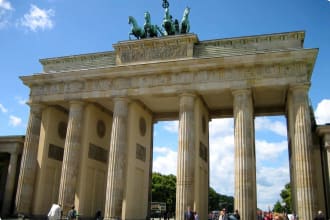
Day 1: Berlin
Accommodation: TBA
Our Grand Tour begins in Berlin, once capital of the Kingdom of Prussia. After unification of the German states in 1871, Berlin became the capital city and remained so until the end of WWII. Divided internally, and from the west of the country, during the communist rule after 1945, Berlin was reunited after the fall of the communist regime, becoming the capital city once again in 1991. Situated on the North German Plain, in the valley of the River Spree, some 180 kilometres south of the Baltic Sea, Berlin is an ancient city. Traditionally it was said that Berlin was founded sometime around the beginning of the 13 th century, although recent archaeological excavations put the date even further back in time.
During our time in Berlin we’ll have time to explore the city and learn something about its tumultuous past.
This afternoon we meet in your Berlin hotel for a briefing on the tour and an introduction to your programme leader and fellow travellers.
This will be followed by a welcome dinner in a local restaurant.
Day 2: Berlin
This morning we begin with a guided tour of the city by coach and on foot. This tour will introduce you to the city’s main attractions including the Brandenburg Gate, the Reichstag Building, Checkpoint Charlie, the Holocaust Memorial, Berlin Cathedral and Museum Island.
Our tour will end at Museum Island and you will have free time to explore one or more of its many museums at your leisure.
This evening you will be free to visit a local theatre or linger over dinner of your own choosing.
Day 3: Berlin
This morning we leave Berlin temporarily and take the train to Hamburg. Here we have a guided tour of the old city in the morning, including a cruise along the River Elbe. In the afternoon there will be time to explore before returning to Berlin.
Day 4: Berlin
Today you have a day free to pursue your own interests. You might like to return to Museum Island, visit theMuseum of German History, take a tour of the rococo Charlottenburg Palace or visit historic Potsdam.
In the evening we meet to visit one of the Berlin theatres or concert halls. The performance of classical music/ballet/or opera will depend on availability.
Day 5: Dresden
We leave Berlin this morning after breakfast and travel via Wittenberg and Leipzig to Dresden where we spend one night.
Wittenberg is particularly important in European history because it is here that Martin Luther pinned his “Ninety Five Theses” to the door of the Castle Church and ignited the Protestant Reformation. We’ll visit this church and the home where Luther lived with his wife and six children. Artist Lucas Cranach the Elder also lived and worked in Wittenberg and his painting of the Ten Commandments can be seen in the refectory of Luther’s house.
In Leipzig we’ll take a guided tour of the old city including a visit the St Thomas Church where Johan Sebastian Bach was choir master between 1723 and 1750. Bach’s remains are interred within the church. Leipzig’s Rathaus (City Hall) was built is 1556 and is considered one of the most beautiful Renaissance buildings in Germany.
In the late afternoon we’ll continue to Dresden where we spend just one night.
Day 6: Prague
This morning we take a guided walking tour of Dresden, known particularly for the devastating firebombing in the final months of WWII which killed 25,000 people and destroyed much of the city. Fortunately much of the city’s past architectural and cultural glory has been restored, most of it since 1990 and German reunification.
We visit one of the most recent restorations, the Frauenkirche, completed in 2005. Originally built from 1726 to 1743, the Protestant Church of Our Lady, in the city’s Old Town, was totally destroyed by Allied bombs in 1945. Sixty years later, through government, corporate and private donations, the church was restored, stone by stone being replaced in its original position.
After lunch we take a cruise along the River Elbe to Pilnitz Castle where our coach will meet us and we continue to Prague where we spend the next four nights. Our cruise shows us Dresden from a different perspective as we pass three famous castles and under four memorable bridges.
Day 7: Prague
This morning we have a guided tour of Prague, a bustling modern city with a medieval past. Founded sometime around 870AD, Prague has withstood numerous invasions, fires and floods. Today it is full of tourists, all eager to explore its many charms. Our tour will include a stroll which takes us around the old town square and across the Charles Bridge. We visit the castle and the St Vitus Cathedral where we can admire the magnificent art nouveau stained glass windows.
In the afternoon, we take a guided tour of Municipal House, Prague’s extraordinary Art-Nouveau cultural centre.
Municipal House stands on the site of the Royal Court, seat of Bohemia’s kings from 1383 to 1483, when the Vladislav II the court moved to Prague Castle. Buildings on the site were demolished between 1906 and 1912 and this magnificent art-nouveau edifice constructed. It was a joint effort by around 30 leading artists of the day, creating a cultural centre that was the architectural climax of the Czech National Revival.
Day 8: Prague
After breakfast this morning we take a day trip to Cesky Krumlov, a medieval city originally built in the 13 th century on both sides of the River Vltava (Moldau) in South Bohemia.
The historic centre of the town is an outstanding example of a small Central European medieval town whose architectural heritage has remained intact thanks to its peaceful evolution over a number of centuries. Founded in the Middle Ages, the town has undergone a number of Renaissance and Baroque transformations, while retaining the street layout of a typical planned Medieval town. On our tour today we’ll visit the old town, the castle and the baroque theatre.
In the afternoon we return to Prague.
Day 9: Prague
Today is at your leisure.
This evening Odyssey will have booked concert tickets.
Day 10: Vienna
We make our way slowly towards Vienna after breakfast this morning. Our first stop will be in Telc where we have time to explore this UNESCO World Heritage Site, before continuing to Mikulov and finally Vienna.
Telc is one of the most beautiful towns in the Czech Republic. The historic centre of town, surrounded by three artificial ponds, was added to the UNESCO list of cultural heritage in 1992, thanks mainly to the chateau and the beautifully preserved town square.
The appearance of the town square is a result of a catastrophic fire in 1530 which destroyed much of the town, When Lord Zacharias of Hradec chose Telc as his seat of government shortly afterwards, he set about turning the stone castle into a residential chateau, and rebuilt most of the town centre to a uniform plan. The main square is completely encircled by arcade-fronted townhouses sill of a similar size and proportion but with fascinating and intricate surface decorations unique to each building. Though it’s a colourful place, ringed with cafes and restaurants, the Telc square has essentially kept the same appearance for centuries and is one of the best examples of Renaissance architecture north of the Alps.
Mikulov is another beautiful old town boasting well preserved historic architecture. The highlight of the town is probably Mikulov Chateau, sitting on a hill and dominating the landscape. The town also has a pretty square with an unusual medieval house decorated with scenes from antiquity and from the Bible.
Late this afternoon we arrive in Vienna.
Day 11: Vienna
Our guided tour this morning introduces us to the main highlights of this large city. We take a walking tour through the old city including a visit to St Stephan’s Cathedral and the City Hall (or Rathaus). During our tour (or at the end) we’ll stop for coffee and cake in one of Vienna’s famous cafes.
Three hundred years ago in Vienna there were cafés for everyone: artists, intellectuals, the respectable bourgeoisie and the not-so-respectable. People gathered in cafés to chat, eat, read, work, play, gamble and discuss. The café provided a place where the rigid social hierarchies of the day could be relaxed a little. Even today, cafes are still a big part of Viennese culture.
This afternoon we visit the Kunthistorisches Museum of Art. We have a guided tour of the main exhibits and then free time to explore.
Day 12: Vienna
Today we take a day tour out of Vienna to explore World Heritage listed Wachau, part of the Danube Valley.
We travel through the Vienna Woods area to Melk where we stop to explore the town and visit the baroque monastery. From Melk we continue along the river through picturesque Spitz and Durnstein. There will even be time to have lunch and visit one of the local wineries.
In the late afternoon we return to Vienna.
Day 13: Vienna
This morning visit Schonbrunn Palace.
Schönbrunn Palace is one of Europe’s most beautiful Baroque complexes and has been in the possession of the Habsburgs since 1569. The wife of Emperor Ferdinand II, Eleonore von Gonzaga, had a pleasure palace built on the site in 1642 and called the property “Schönbrunn” for the first time. The palace and garden complex created from 1696 onwards following the siege of Vienna was complete redesigned under Maria Theresa after 1743. Today, due to its historical significance, its unique layout and magnificent furnishings, the palace is a UNESCO World Heritage site.
The afternoon will be free to explore, visit another museum, take a stroll through the old city or simple relax.
This evening, we attend a oncert at one of Vienna’s many excellent music venues.
Day 14: Budapest
We travel to Budapest via Bratislava, the capitol of Slovakia. In Bratislava’s we take a guided city tour, visiting the castle and the Old Town Hall.
After lunch we continue to Budapest.
Day 15: Budapest
Today’s guided tour of Budapest by coach and on food gives us an introduction to the city highlights in both Buda, and across the river in Pest. Our tour will include a visit to the splendid Parliament House, St Stephen’s Basilica and the Fisherman’s Bastion.
This afternoon, the group has a walking tour of the old city.
Day 16: Budapest
Today is free day to explore. You might like to sample one of the famous Budapest Baths, or visit one of the numerous Art Museums.
Day 17: Keszthely region on Lake Balaton.
Today we take leisurely drive along the shores of Lake Balaton, stopping to explore a number of the picturesque towns along the way to our overnight stop in (or near) Keszthely. We’ll explore a number of small towns such as Tihany, Szigliget and Tapolca before we arrive in Keszthely where we visit the Festetics Castle. The castle was built by Gyorgy Festetics in 1745 and is one of the largest and most beautifully restored buildings in Hungary.
Day 18: Ljubljana
We leave Keszthely this morning and head into Slovenia. Our first stop will be in Maribor where we’ll take a stroll through the old town and have time for coffee.
On arriving in Ljubljana, the capital city of Slovenia, we’ll take a lunch break before a guided tour of the old city.
Day 19: Ljubljana
Today we visit beautiful Lake Bled. At Lake Bled we visit the castle, take a pletna (boat) across to the church on Bled Island in the lake, and have the chance to take a 6 kilometre stroll around the lake on an easy walking path. We may even have the opportunity to drop in to one of President Tito’s summer holiday homes for coffee and one of the regions famous cream cakes.
In the afternoon we return to Ljubljana.
Day 20: Plitvica Lakes area
Today we travel to the Plitvica Lakes area via a visit to the Postojna Caves before continuing to the the Croatian coast. On our way down the coast we visit the town of Senj and take a walk through the old city.
Day 21: Plitvica Lakes area
We have a whole day to explore the beautiful World Heritage listed Plitvica Lakes National Park
Plitvice Lakes National Park, Croatia’s largest national park covering almost 30,000 hectares, is situated in the lower elevations of the Dinarides in the central part of the country. Within a beautiful karst landscape dominated by a mix of forests and meadows, the magnificent Plitvice lake system stands out, fascinating scientists and visitors alike.
Day 22: Trogir
From Plitvica National Park we continue along the coast to the city of Zadar and then to Trogir where we spend the night.
Zadar is a historic destination on the Dalmatian coast that combines an abundance of Roman and medieval remains with innovative modern architectural projects. While the city prospered during the 17th and 18th centuries as part of a wealthy maritime republic, its many old churches and palaces have now been repurposed into unorthodox art galleries, lively bars and cheerful cafés.
Zadar’s central square is essentially an outdoor museum, where you can find historic buildings like the 11th-century Church of St Lawrence and the 16th-century Clock Tower. Located on the south side of the square, the City Loggia once housed the courthouse and council chambers, but now serves as an exhibition space for international photographers and contemporary Croatian artists.
At first glance, the Sea Organ installation looks like a series of steps leading into the ocean – it’s actually a huge musical instrument designed by Nikola Bašić. There are hollow tubes underneath the marble steps that make music when the waves pass through them, creating a harmonica effect. During sunny weather, locals like to sunbathe on the steps or splash about in the shallow waters.
Trogir was designated a World Heritage Site in 1997 and is home to a number of great historic sites including the Cathedral of St Lawrence. Although findings in the local area suggest that there must have been settlements at the site of Trogir in prehistoric times, the town’s history really starts with a Greek settlement in the 3rd century BC. Greeks from the island of Vis founded the settlement Tragurion, which then went on to become part of the Roman Empire which was expanding through Dalmatia at that time.
Trogir came under Hungarian and Croatian rule over the next few centuries, including the rule of Croatian-Hungarian King Bela IV in 1242. In 1420, again as with much of Dalmatia, it became part of the Venetian Empire, until the Empire’s fall in 1797. Trogir then became part of the Austrian Empire (with brief French occupation in the early years of the 19th century).
These many occupations have all left their marks on Trogir making it a fascination city to explore.
Day 23: Dubrovnik
We leave Trogir this morning and drive the short distance to Split where we have a guided tour of the city including the palace of the Roman Emperor Diocletian.
Split is a vibrant port city known for its ancient centre, beautiful architecture, and exquisite cuisine. Diocletian’s Palace, probably the city’s main attraction, was built for the Roman Emperor Diocletian during the 4 th century AD. A well-preserved UNESCO World Heritage Site, the palace is home to notable attractions such as the Cathedral of Saint Domnius (offering magnificent views from its tower), Temple of Jupiter, Peristyle Square, and a statue of Marko Marulic – the founder of Croatian literature.
From Split we continue south along the coast to Dubrovnik.
Day 24: Dubrovnik
This morning we have a guided tour of the old city of Dubrovnik.
This afternoon you are free to spend more time exploring the old city. You might like to walk around the city walls or visit the the 15 th century Rector’s Palace. On the other hand you could take a long lunch in a restaurant with a view across the water or do some shopping in one of the many art and craft galleries.
Day 25: Montenegro
Accommodation: Overnight Ferry to Bari
This morning we take a trip to Kotor in neighbouring Montenegro.
Located on a beautiful bay on the coast of Montenegro, Kotor is a city steeped in tradition and history, with remarkable scenic views. A UNESCO World Heritage site, the old city was built between the 12th and 14th centuries and is filled with medieval architecture and historic monuments. Extending over four kilometres, the city walls that have protected Kotor for centuries lead up to the fortress of Saint Ivan.
When it comes to the history, Kotor has been an important town since the early Middle Ages because of its strategic location on a bay where ships can shelter.
Over the centuries, the town expanded and the buildings were influenced by the various empires that controlled it – Dalmatians, Bulgarians, Serbians, Hungarians. But it was under the Venetians that it took most of its current form.
Kotor was part of the Republic of Venice from 1420 to 1797. So it’s no great surprise that, when you walk through the Old Town of Kotor, most of the architecture is in the Venetian style.
After lunch we return to Dubrovnik and in the evening board the overnight ferry to Bari, Italy.
Day 26: Matera
After we land in Bari we rejoin our coach and drive to Alberobello to spend some time exploring this unusual town.
The town of Alberobello is among the most famous of the Apulia region’s attractions, because of its collection of trulli – whitewashed stone huts with conical roofs that have been around for centuries.
No one is exactly sure when the first trullo was erected, but it’s thought that some date back to the mid 14th century. There’s also a lot of discussion about why they were first built – some sources say they were originally used as storehouses and field shelters, others say they were permanent homes of small-time landowners or labourers. One of the most interesting theories is that they were an elaborate form of tax evasion – landowners didn’t want the authorities to know Alberobello existed because they’d have to pay taxes. When the authorities did investigate, the key stonework was removed and the locals hotfooted it to the country. The huts took six months to rebuild and this mad system continued for around 300 years until Alberobello was made an official village (now, it’s considered a small town). Today, the site houses 1,500 of these tiny fairytale-like huts, which house hotels, private residences, restaurants and bars.
From Alberobello we continue to Matera where we spend the night. Matera, once considered Italy’s “shame”, is now a European city of culture and UNESCO World Heritage site.
The caves of Matera had been inhabited for centuries; some humble and some smarter residences, but by the early twentieth-century the area was a by-word for poverty. Until the 1950s hundreds of families were still living crowded into cave-houses here. The squalor and malaria-ridden conditions became a national scandal and finally the cave residents were moved – by law – to modern buildings on the plateau above. By the 1980s the abandoned caves of Matera were no longer scandalous, but fascinating reminders of the past. A few rather more well-to-do residents moved back and renovated old cave houses. In 1993 the town was made a UNESCO World Heritage site, for being “the most outstanding, intact example of a troglodyte settlement in the Mediterranean region, perfectly adapted to its terrain and ecosystem”.
After lunch we have a guided tour of the city.
Day 27: Naples
We leave Matera this morning and continue to Naples via Pompei and Herculaneum.
When Vesuvius erupted in 79 AD, it engulfed the two flourishing Roman towns of Pompeii and Herculaneum, as well as the many wealthy countryside villas in the area. Pompeii was buried largely by a thick layer of volcanic ash and lapilli and Herculaneum disappeared under pyroclastic surges and flows. These sites have been progressively excavated and made accessible to the public since the mid-18th century.
In the case of Herculaneum large areas of the ancient town still lie under the modern town and have only been explored and surveyed by the network of 18th-century tunnels that drew the attention of Grand Tour visitors, the basis still today for visiting the Herculaneum’s underground ancient theatre.
Pompeii, with its well-preserved buildings in an excavated area of 44 ha, is the only archaeological site in the world that provides a complete picture of an ancient Roman city. The main forum is flanked by a number of imposing public buildings, such as the Capitolium, the Basilica and temples and within the city there are also many public bath complexes, two theatres and an amphitheatre.
From Herculaneum we continue to Naples.
Day 28: Naples
We begin this morning with a guided tour of Naples.
Naples has a long and interesting history. Founded by Greek colonists, the city was conquered by the Romans in 326 BC. From then until the unification of Italy the city was ruled by a number of different groups including the Byzantines, the Normans, the German Emperor and the Spanish royal family. During this time its fortunes waxed and waned leaving behind a rich legacy or art and architecture.
In the afternoon we visit the Archaeological Museum.
Day 29: Naples
We spend a second full day in Naples exploring the city, its streets, museums, arcades, castles and churches. We are on the trail of Caravaggio today as part of the walking program of this city.

Day 30: Naples
Our full day excursion is to Sorrento and Capri
Day 31: Naples
Today is at your leisure
Day 32: Orvieto
Leaving Naples this morning we take the coast road to Civitaveccia and then head inland to Orvieto where we spend the next four nights.
Orvieto, perched dramatically on a tufa rock, displays its long past better than almost any other city in Italy. Here we can go underground into the tunnels that honeycomb the rock on which the city sits. These tunnels are at least two and a half thousand years old and, along with the tombs outside the old city, tell us much about the Etruscans who built them. Orvieto has a medieval cathedral, a Renaissance well and a 19 th century theatre, along with modern shops and great restaurants. While in Orvieto we visit the neighbouring town of Todi. We’ll also have time to wander through the twisting streets, and walk along the medieval walls with fabulous views down into the valley below.
Day 33: Orvieto
We begin with a guided tour of the city including the beautiful cathedral, the theatre, and St Patrick’s Well.
In the afternoon we take a tour of the Etruscan tunnels underneath the city and visit the Etruscan cemetery.
Day 34: Orvieto
Today we visit Todi, another spectacular hilltop town. Perched on tall two-crested hill overlooking the east bank of the River Tiber, it commands spectacular views in every direction.
Todi has one of central Italy’s most photographic piazzas, the Piazza del Popolo which is enclosed by the 13 th century Palazzo del Capitano and Palazzo dei Priori. Surveying it from one end is the rose window of Todi’s Romanesque- Gothic Cathedral. Below the square are vast Roman cisterns, built in the 1 st century BC, and over 80 metres long. The cisterns were part of a rainwater storage and drainage system that carried water from the Forum to the valley below.
There is much to see in Todi and we’ll have the day there to explore the city, before returning to Orvieto.
Day 35: Genoa
Genoa is a large modern city with a long history. The city’s architecture speaks of its former glory as the “Most Serene Republic of Genoa” which ruled much of the Mediterranean in the 12 th and 13 th centuries. Genoa has more than 100 palazzi, all attesting to the wealth of the city’s ruling class in the 16 th and 17 th centuries when this was one of Europe’s most successful trading nations, and many of these are open to the public. There is also a busy modern port, which has been recently transformed by local architect Renzo Piano. The museums are crowded with art, but not with other tourists, and the city is a maze of medieval streets just waiting to be explored.
This morning we head towards Genoa, stopping at the small medieval town of San Gimignano along the way. San Gimignano is a walled village which has been recognised as a UNESCO World Heritage Site since1990. The town is famous for its fascinating medieval architecture and the towers that rise above all the other buildings. At the height of its glory, San Gimignano’s noble families built around 72 tower-houses as symbols of their wealth and power. Although only 14 of the towers remain, San Gimignano still retains much of its medieval appearance.
We will take a guided tour of the town and have time for lunch before continuing to Genoa.
Day 36: Genoa
This morning we take a guided tour of the city’s medieval centre, including a visit to the 12 th century cathedral Di San Lorenzo.
This afternoon we visit the Palazzo Rosso and/or Palazzo Bianco.
Day 37: Genoa
Today we concentrate on Genoa’s Porto Antico. We have a guided tour of Genoa’s rejuvenated old port which has been transformed by architect Renzo Piano. He designed the new aquarium, a Biosphere with a botanical garden, and the “Bigo” Crane. The Galata Maritime Museum, the largest and most innovative maritime museum in the Mediterranean, lies close to the aquarium, and as no visit to Genoa would be complete without a visit to the Maritime Museum, we will spend the rest of the morning there.
This afternoon we take a cruise upon the harbour, possibly as far as Portofino, for great views of the city.
Day 38: Genoa
This morning we have a guided tasting tour of the old city to explore different aspects of the city’s culinary delights.
This afternoon you have free. You might like to visit some of the other Heritage listed palazzi in the city such as the Palazzo Ducale or the Palazzo Reale. The Palazzo Ducale, right in the heart of the old town, was yet residence of a number of the doges who ruled the city from 1384 to 1515. The Palazzo Reale, built by the Balbi family in the early 17 th century, has a grand ballroom, stucco ceilings and some wonderful works of art, including Van Dyck’s “Crucifixion”.
Day 39: Arles
This morning we leave Genoa and Italy, making our way into France. We follow the coast road as far as Nice and then continue to Arles via Aix-en-Provence.
On our way we take time to stop and admire the scenery and spend some time exploring Nice.
Arles offers distinctive Provençal character along with a wealth of cultural attractions. This charming small town is steeped in history dating back to its origins as a Greek settlement. Arles then became one of the most important cities of the Roman colony called “Gaul,” founded by Julius Caesar in 46 BC. Arles boasts wonderfully preserved ruins, including the ancient Arena, Roman Theatre, the Forum, and the Baths of Constantine. These archaeological sites make Arles one of the best places to explore the region’s Roman heritage.
Day 40: Arles
This morning we take a guided tour of Arles concentrating on its many fine Roman sites. The UNESCO listed Roman Amphitheater (Arènes d’Arles), dating back to the 1st century AD, is the largest and best preserved ancient monument in Arles. With a length of 136 meters and a width of 107 meters, the arena was one of the largest in Gaul and could accommodate 21,000 spectators.
This afternoon we have a guide who takes time to show you the centre of Arles and its history post Roman. Possibly including a visit to the Museum of Antiquities and stories about Van Gogh.
Day 41: Arles
This morning we drive to Avignon to explore a little of the city and visit the Palace of the Popes, as well as the famous Pont d’Avignon.
In the 14th century Avignon was the most important city in Europe: It was the seat of the Catholic church, represented in spectacular style by the Palais des Papes, the largest gothic building in the world.
We return to Arles via the Pont du Gard, built in the 1 st century AD, it is one of the best preserved of the Roman aqueduct bridges . The bridge, which spans the river Gardon, is 48metres high and is the largest section of a 50 kilometre aqueduct built by the Romans to carry water from the Uzes valley to the city of Nimes.
Day 42: Arles
A day in the Camargue
Enclosed by the Petit Rhône and Grand Rhône rivers, most of the Camargue wetlands fall within the 850-sq-km Parc Naturel Régional de Camargue, established in 1970 to preserve the area’s fragile ecosystem, while sustaining local agriculture. It’s a stunning and precious environment in which age-old farming practices coexist with one of Europe’s greatest havens for birdlife.
Covering more than 900 square kilometres to the south of Arles it is a large, flat area of marshes, fields, salt-flats and lakes, and the largest river delta in Europe.
The Camargue Regional Natural Park is also home to an astonishing range of wildlife, including semi-wild bulls, the renowned Camargue Horses, and many hundreds of species of birds. Other wildlife includes wild boars, badgers, flamingos, tree frogs and water snakes.
Day 43: Narbonne
After leaving Arles we head south through Montpellier to Narbonne where we spend just one night.
We take time in Montpellier to explore the medieval city streets, drink some coffee and visit the Musee Fabre (considered to be one of the finest Fine Arts museums in Europe).
From Montpellier we continue to Narbonne where we visit Les Halles, the stunning steel and glass covered market built at the beginning of the 20 th century, one of the most beautiful markets in France.
Narbonne’s historical quarter, a short walk away from the market, is lined with lively cafes and boutiques, and centres on an excavated strip of Via Domitia, the antique Roman route that connected Rome to the Spanish peninsula. Little else remains standing of Narbonne’s Roman past, but (time permitting) we’ll be able to explore the Horreum, underground galleries that probably served as a food warehouse in the 1st century B.C. Well-lit and preserved, they bring to life the habits of the inhabitants of Narbo Martius, the ancient Narbonne.
Day 44: Barcelona
This morning we continue south into Spain, and stop at Figueres and Girona on our way to Barcelona.
The historic centre of Figueres is bounded by remains of its old wall, put up in the Middle Ages to defend the town. Beautiful corners from the medieval period are preserved, like the Plaza del Ayuntamiento, remodelled in Neoclassical style and where the council building stands, or the area around Carrer Magre, where there old Jewish quarter was located.
Without doubt, however, one of the historical milestones that has left the greatest mark on the character of the town was the birth of Salvador Dalí. The Dalí Theatre-Museum, situated in the old municipal theatre, has become one of the main cultural places to see in the city. Designed by the artist himself, it holds an important exhibition, which, through numerous works, allows you to take a trip through the career of the main considered a master of Surrealism. The site was extended with the Torre Galatea, where the artistic genius died.
We visit the Dali museum before continuing after lunch to Girona. The Roman town of Gerunda lay on the Via Augusta from Gades (now Cádiz) to the Pyrenees. Taken from the Muslims by the Franks in the late 8th century, Girona became the capital of one of Catalonia’s most important counties, falling under the sway of Barcelona in the late 9th century. Girona’s wealth in medieval times produced many fine Romanesque and Gothic buildings that have survived repeated attacks, while a Jewish community flourished here until its expulsion in 1492.
Day 45: Barcelona
This morning we visit Gaudi’s magnificent Sagrada Familia.
Construction began on the Sagrada Família in 1882, but remarkably the architect Antoni Gaudí did not become involved with the project until 1883 and was appointed director in 1884. Gaudí was aware that he would not be alive to oversee the full construction of the building but left detailed designs to guide its completion. In fact only a quarter of the construction had been completed in 1926 when Gaudi died unexpectedly. The building of the church is still not complete today, and it is estimated that the current construction represents only 70% of the final design. Despite this, the edifice was consecrated by Pope Benedict XVI in 2010 and declared a minor basilica.
This afternoon we visit Park Guell, another Gaudi masterpiece. Located right on the edge of Barcelona Park Guell is a beautiful park full of bright colours, interesting architecture, lush greenery, and more!
The park is named after Eusebi Güell, a rich entrepreneur, who commissioned Gaudi to build a luxury residential complex. When the project was abandoned, Gaudí designed a park. Created between 1900 and 1914, Park Guell has been open to the public since 1923.
In 1984, it was declared as a World Heritage Site by UNESCO. The park was made following the architectural style that made Gaudi famous: Catalan Modernism. Spread across 19 hectares, you will find rounded forms, undulating lines, and structures covered in rainbow-coloured mosaic and iron gates come together to create an extraordinary space.
Day 46: Barcelona
This morning we have a guided city tour of Barcelona including a tour of the stunning Palau de la Musica and a visit to the cathedral.
The afternoon with a guide we explore the old city and visit one of the art museums.
Day 47: Barcelona
Today you are free to explore. You might like to visit one of the Gaudi apartment buildings, another of the great art museums, linger over a long lunch or simply wander through the city admiring the amazing architecture.
Day 48: Valencia
This morning we leave Barcelona and arrive in Valencia in time for lunch. In the afternoon we take a city tour that includes a visit to the Plaza de la Reina, with its cathedral and Miguelete tower. The tower was built in 1381 and those willing to climb its 207 steps will have stunning views across the city. In the city centre we will also visit the Silk Exchange, a World Heritage Site, and one of Valencia’s most beautiful buildings.
Day 49: Granada
We leave Valencia after breakfast and continue to Granada. On our way to Granada we stop for lunch in the city of Murcia and take time to explore the city.
Although the region of Murcia has been inhabited for more than 2,000 years, the city was not founded until 831, when the Emir of Cordoba Abd ar-Rahman II commissioned a walled city on the banks of the river Segura, to be the provincial capital under the Caliphate. Today, many places in the city still evoke its Moorish past.
The old town is situated next to the river Segura, with historical streets which still bear the names of the Medieval guilds that used to work there. In Plaza Cardenal Belluga there are two architectural gems – the Episcopal Palace (18th century), with a rococo façade, and the Cathedral, begun in the late 14th century, and notable for its combination of architectural styles.
In the afternoon we continue to the city of Granada
Day 50: Granada
Today we spend exploring the city.
Granada has an unmistakably Moorish flavour, as it was the last city to be reconquered by the Catholic Monarchs in 1492. In the morning we visit the historic, World Heritage listed, Albaicin district including a visit to the Alhambra. This district was an important cultural centre for many centuries under both Islamic and Christian rulers.
The Alhambra is a beautiful complex of buildings and gardens. Its leafy tree-lined walkways provide pleasant shade and coolness, enhanced by the abundance of water that flows in its streams. It was the largest political and aristocratic centre of the Moslem West. The Palace premises comprise beautiful rectangular courtyards and numerous fountains, as well as the Nasrid buildings that served as living quarters for the monarchs and their servants.
In the afternoon we explore the city centre and visit the Cathedral.
Day 51: Seville
We leave Granada after breakfast and travel to Seville via Cordoba where we’ll have time for lunch and to explore the wonderful Mosque-Cathedral.
Founded by the Romans in the 2nd century BC near the pre-existing Tartesic Corduba, capital of Baetica, Cordoba acquired great importance during the period of Augustus. It became the capital of the emirate depending on Damascus in the 8th century. In 929, Abderraman III established it as the headquarters of the independent Caliphate. Cordoba’s period of greatest glory began in the 8th century after the Moorish conquest, when some 300 mosques and innumerable palaces and public buildings were built to rival the splendours of Constantinople, Damascus and Baghdad. In the 13th century, under Ferdinand III, Cordoba’s Great Mosque was turned into a cathedral and new defensive structures, particularly the Alcazar de los Reyes Cristianos and the Torre Foraleza de la Calahorra, were erected.
We continue to Seville in the afternoon.
Day 52: Seville
We begin the day with a guided tour of the city centre including a visit to the cathedral and the Real Alcazar.
The Real Alcazar de Sevilla is the Royal Palace of Seville. The name ‘ Alcazar ‘ means castle in Spanish and is derived from the Arabic word al-qasr (fortress or palace). The complex of palaces is in the Mudéjar style, which is a architectural style with many influences from Moorish and Christian culture. It is probably the oldest palace still in use in Europe; when King Felipe V visits Seville, this UNESCO listed palace is still his residence.
In the year 913, Abd-ar-Rahman III (the first caliph of Al-Andalus) gave the order for the construction of a castle on this site where a Roman fortress once stood. The castle was further expanded into a palace by King Al-Moetamid (the last king of the Abbadid dynasty) in the 11th century. In the 14th century, the Spanish recaptured the palace from the Moors, after which King Alfons X of Castile expanded the palace. In 1364, King Peter I of Castile (‘The Cruel’) ordered the construction of a new palace, the Alcázar, after which his successors continued to build the palace.
In the afternoon our local guide continues to guide the group through the city.
Day 53: Seville
Accommodation: Seville
Day 54: Lisbon
From Seville we continue our exploration of the Iberian Peninsula as we head to Lisbon, the capital of neighbouring Portugal.
We travel to Lisbon via the Parque Natural do Vale do Guardiana.
Created in 1995, this zone of hills, plains and deep valleys around Serpa and Mértola shelters the Rio Guadiana, one of Portugal’s largest and most important rivers. Among its rich flora and fauna are several rare or endangered species, including the black stork (sightings of the shy creatures are rare), lesser kestrel (most likely around Castro Verde and at Convento do São Francisco), Bonelli’s eagle, royal owl, grey kite, horned viper and Iberian toad. The park also has prehistoric remains.
Day 55: Lisbon
Lisbon is one of Europe’s most beautiful and cosmopolitan cities. Set over a series of hills near the mouth of the River Tagus, it’s a place inextricably linked with the sea. Intrepid navigators embarked from here in the 15th and 16th centuries to sail unknown waters and chart new lands, and the legacy of this golden Age of Discovery underpins much of the city’s culture and heritage.
This morning we take a guided tour of the city including a visit the the Castello of St George and a walk through the Alfama district. The Castle of St George is one of Lisbon’s most popular tourist destinations. Its impressive battlements, engaging museum, and fascinating archaeological site combine to make the castle a rewarding experience for all visitors.
While in the Alfama district we visit Lisbon’s fortified Romanesque cathedral — the Sé — which has undergone several design makeovers since the original structure was consecrated in 1150. A series of earthquakes culminating in the devastating 1755 tremor completely destroyed that which stood in the 12th century.
What you see today is a blend of architectural styles, the standout features being the twin castellated bell towers that embellish the downtown skyline — particularly evocative in the late afternoon when a setting sun burnishes the brickwork with a golden veneer.
This afternoon our guide shares stories in one of the museums of the importance of maps and trade for the Portuguese.
Day 56: Lisbon
After breakfast we visit the Belem district and the Mosteiro dos Jeronimos (the Monastery of St Jerome). The monastery was commissioned to commemorate Vasco da Gama’s discovery of a sea route to India in 1498. The UNESCO listed building was once populated by monks of the order of St Jerome, whose spiritual job for four centuries was to comfort sailors and pray for the king.
This afternoon is at your leisure.
Day 57: Sintra
Today we take an excursion to Sintra. Sintra is a charming Portuguese town situated within the cooling hills of the Serra de Sintra. Hidden among its majestic pine forest, you will discover whimsical palaces, extravagant villas and the ruins of a 10th-century Moorish castle.
One of the most important sites in Sintra-Vila is the Palacio Nacional de Sintra with its twin conical chimneys and lavish interior. It is a mix of styles with arabesque courtyards, barley-twist columns and 15 th /16 th century geometric tin glazed tiles that are among Portugal’s oldest. The palace is of Moorish origins but expanded under the Christian rulers in the 13 th to 16th centuries.
Day 58: Porto
This morning we leave Lisbon and travel north to Porto. We take a break in Coimbra to explore the city centre.
Rising scenically from the Rio Mondego, Coimbra is an animated city steeped in history. It was Portugal’s medieval capital for more than a century and it’s home to the country’s oldest and most prestigious university. Its steeply stacked historic centre dates to Moorish times and is wonderfully atmospheric, with its dark cobbled lanes and monumental cathedral.
This afternoon we continue to Porto where we spend the night.
Day 59: Leon
On our way to Leon we stop in the town of Braganca, close to the border between Portugal and Spain.
The name of the region of which Braganca is the capital, is easily the most remote part of mainland Portugal. Here, ancient stone houses still cluster in small villages that seem unaffected by the speed and complexities of modern life, rich traditional dishes still fill the bellies of hard-working farmers and the general feel is one of pleasing distance, both physical and other, from the busier, more cosmopolitan parts of the country. This is a beautiful, rugged but isolated region.
Bragança, the town, stands proudly on a plateau only a matter of a few kilometres away from the Spanish border. Known in Celtic times as Brigantia and and by the Romans as Juliobriga , its hilltop location has appealed to many a defending population. It was the royal seat of the Dukes of Bragança until the dissolution of the monarchy in 1910, indeed the royal consort of English King Charles II , Catherine of Bragança , hailed from here.
In the afternoon we continue to Leon.
Day 60: Leon
Leon, once the Roman Legio VII Gemina Pia Felix, preserves an interesting Romanesque, Gothic and Renaissance legacy, the result of its splendour during the Middle Ages. The Plaza Mayor forms the centre of this city, crossed by the river Bernesga. Among this baroque collection of buildings stands the City Hall, popularly known as the “Balcony of the City”, since from its galleries the nobles observed the town’s activities taking place. Over the course of time, León became the capital of the kingdom in the Middle Ages, a historic enclave on the Pilgrim’s Road to Santiago de Compostela.
Our city tour this morning allows us to explore the city’s Roman past as well its Medieval splendour. Our tour will include a visit to what has been called one of the most significant sites in the whole of Europe, the Basilica de San Isidoro. Its thick walls jealously guard what is known as the “Sistine Chapel” of the Spanish Romenesque style. It is a series of frescoes from the 12 th century which decorate the underground crypt of the Royal Pantheon and which still preserve their original colour.
The afternoon will free to rest or continue to explore.
Day 61: Burgos
This morning we leave Leon for Bilbao, stopping at Burgos which was the capital of the unified kingdom of Castilla-Leon for five centuries, and boasts a masterpiece of Spanish Gothic architecture: the cathedral of Burgos.
The architectural masterpiece of Burgos is the cathedral, declared World Heritage Site by UNESCO. Erected on top a Romanesque temple, the cathedral was built following a Norman French Gothic model. The filigree work in the spires of the towers and in the exterior of the High Constable Chapel, are some of the masterpieces found in this cathedral. Such beauty and incredible genius lead to a long list of exceptional works of art in its interior. These include the starry dome that covers the tombs of El Cid and Doña Jimena, the choir, the sarcophagi and the Golden Staircase, built by Spanish architect and sculptor Diego de Siloé, a prominent figure during the Spanish Renaissance.
In the afternoon we explore Burgos historic city centre.
Day 62: Bilboa
We continue to Bilbao where we take a coach tour through the city past much of its surprising modern architecture.
After lunch the group visits the Guggenheim Museum. It is one of the most surprising examples of 20th century architecture as Frank Gehry used 33,000 ultra-thin titanium plates to create its curious curves. Inside, it shares the world’s most important private collection of modern and contemporary art with New York and Venice.
Day 63: Bilboa
Bilbao is home to another of Spain’s most important art museums: the Museum of Fine Arts.The city’s commitment to creating a ground-breaking, imaginative image also includes the Euskalduna Conference Centre, Norman Foster’s metro stations, the Isozaki and Pelli towers, the Zubizuri bridge designed by Calatrava or new cultural centres such as La Alhóndiga by Philippe Starck, built over an old wine cellar.
On the other hand, it’s impossible to imagine Bilbao without its characteristic old town, with over 700 years of history. It’s a pleasure to stroll around the famous “Seven Streets” and discover iconic buildings such as the Cathedral or the elegant theatre inspired by the Paris Opera House, the Arriaga, and a mix of shops and cafes.
Day 64: Bordeaux
This morning we leave Spain and return to France.
On our way to Bordeaux we stop in the French Basque city of Bayonne, stretching along the banks of the Adour and Nive rivers. Bayonne, only a short distance from better known Biarritz, has been a strategic stronghold since medieval times and the old ramparts are still visible around the outskirts of the old town.
Bayonne’s is particularly memorable for its pretty half-timbered buildings and shady cobbled streets. We will have time for lunch and a visit the the Gothic cathedral. Construction for the cathedral began in the 13 th century though it was not completed until 1451. Above the north aisle are three lovely stained glass windows. There are also several beautifully restored frescoes.
This afternoon we continue to Bordeaux where we explore the old city centre. This evening we may be able to visit the Grand Theatre (an 18th-century architectural masterpiece by Victor Louis) depending on the availability of performances and tickets on the night we spend in Bordeaux.
Day 65: Tours
On our way to Tours this morning we stop for coffee in the village of Verteuil-sur-Charente situated on the banks of the river Charente. The village is dominated by the castle that stands above the picturesque river banks. There will be time for a stroll through the village before we continue our journey.
Our next stop will be in Poitiers where we explore the historic town centre before continuing to Tours. In the Middle Ages Poitiers really came into its own and there are several impressive buildings dating from this time. Most important is the church of Notre Dame la Grande, which was consecrated in the year 1086. With its ornately decorated facade, Notre Dame la Grande is one of the finest examples of western French Romanesque architecture. Poitiers also has a fine early gothic cathedral, built in the 12th century on the instigation of King Henry II of England and his wife Eleanor of Aquitaine. The cathedral has some beautiful medieval stained glass windows.
From Poitiers we continue to Tours where we spend the next three nights.
Day 66: Tours
Today we visit two of the Loire chateaux, probably Chenonceaux and Amboise.
In the afternoon we have a guided tour of the old city including the cathedral.
Day 67: Tours
Today is a day at your leisure.
Day 68: Rouen
On our way to Rouen we stop at Chartres Cathedral, one of the most beautiful in France.
The cathedral in Chartres, known as Cathédrale Notre-Dame de Chartres (Cathedral of Our Lady of Chartres), is widely thought to be the high point of French Gothic art and architecture. This remarkably well preserved cathedral, which survived both the French Revolution and World War II, was built between 1194 and 1250. From the Middle Ages the cathedral was an important place of pilgrimage, though travellers today are probably more attracted to the exquisite 13th century frescoes and stained-glass windows.
From Chartres we continue to Rouen, with time this afternoon to explore the city centre.
Day 69: Lille
We leave Rouen this morning on our way to Lille. We travel via Amiens with time to explore the old city and visit the UNESCO World Heritage listed cathedral.
The town of Amiens is best known for the impressive 13th century Amiens Cathedral of Notre-Dame, the largest gothic style cathedral in France.
The cathedral is still one of the tallest structures in the city with a spire climbing nearly 122 metres into the air. You can see the skeletal stone structure on the exterior of the church, where flying buttresses support the upper walls. The lace-like façade is made up of slender colonnettes and screen-like openings, heightening the contrast of light and shadow.
Within walking distance of the cathedral, the city gives way to a 65-kilometre network of canals coursing through reclaimed farmland with small houses. These floating gardens are the vegetable plots of the “hortillons”, market gardeners who have been working these lands since medieval times. We may even, time permitting, be able to take a barge tour through these floating gardens.
From Amiens we continue to Lille where we have time this afternoon to explore the historic centre with its restored baroque buildings and cobblestone streets.
Day 70: Lille
Today our guide shows us Lille and we explore its history. We fin ish early afternoon.
Day 71: Bruges
This morning we visit a number of sites associated with WWI before continuing to historic Bruges.
We begin in Ypres with a visit to the Flanders Fields Museum located on the impressive Cloth Hall. The recently renovated museum, highlights the story of the invasion, the trench war and the remembrance since the armistice, while focusing on personal stories. It is also possible to climb the bell-tower for impressive views across the former battle fields.
While in Ypres we visit the Menindee Gate before continuing to Passchendaele, a name which has become synonymous with senseless military violence. The dugout tunnel with communication and dressing post, headquarters, workplaces and dormitories, gives us an idea of how the soldiers had to live underground, like moles, because there was nothing left above ground. It’s impressive, as is the Museum with its collection of historical artefacts, images, movies and dioramas.
We arrive in Bruges this afternoon with time to wander around the historic centre, a UNESCO World Heritage Site since 2000. After dinner tonight you might like to take a stroll around the flood-lit city centre. It is also possible to take a guided night tour.
Day 72: Bruges
Our local guide shows up Bruges. Time is spent learning about this merchant city.
Today we explore Bruges; with a canal ride, wander the picturesque streets and parks, drink the famous beer, indulge in the fabulous chocolates, buy some lace, visit the churches and the old St John’s Hospital (built 1188) and enjoy the extraordinary art treasures accompanied by your guide
The Groeningemuseum, home the one of the best collections of art in Belgium, also goes by the name of the Bruges Museum of Fine Arts. With paintings dating back as far as the 14th century and right up to the present day, the Groeningemuseum has become known for its extensive collection of Flemish primitives, with many treasures by famous Belgian artists.
Although the Memlingmuseum may be relatively small, its attractions are big and include six true masterpieces, created by acclaimed German artist, Hans Memling (1430 – 1494). The Memling Museum itself is housed within the chapel of the 12th-century Hospital of St. John (St. Janshospitaal) and home to Memling’s famous St. Ursula Shrine, which is constructed with painted and guilded woodwork. Next door is the Apotheek, a 17th-century pharmacy which was once part of this medieval hospital.
The day is full of history.
Day 73: Amsterdam
Our first stop today will be in Breda where we have time for coffee and a stroll through the historic centre.
From Breda we continue to The Hague, administrative centre for The Netherlands. Here we visit the Mauritshuis which boasts works from the leading masters from 17th and 18th century Netherlands and Flanders. Examples are Girl with the Pearl Earring by Vermeer, The Anatomy Lesson of Dr. Nicolaes Tulp by Rembrandt, and The Goldfinch by Fabritius. You can also admire works by Rubens, Jan Steen and Frans Hals at the Mauritshuis. The exceptional collection and the building’s royal allure have earned it the nickname ‘the jewelry box’.
Day 74: Amsterdam
Today with a local guide the group explores on foot the history of Amsterdam.
This evening we have our farewell dinner in Amsterdam.
Day 75: Amsterdam
Tour concludes after Breakfast.
Includes / Excludes
What’s included in our Tour
- 74 nights of hotel accommodation.
- 74 breakfasts and 20 dinners.
- Applicable entry fees and services of local guides.
- Touring by comfortable and modern coach.
- Field trips as indicated.
- Gratuities and necessary tips.
- Services of an Odyssey program leader.
- Detailed tour information booklet.
What’s not included in our Tour
- Return international airfare and departure taxes.
- Comprehensive international travel insurance.
- Items of a personal nature such as telephone calls and laundry.
- Meals not specified in the itinerary.
Participants must be able to carry their own luggage, climb and descend stairs, be in good health, mobile and able to participate in 3-5 hours of physical activity per day, the equivalent of walking / hiking up to 8 kilometers per day on uneven ground.
21 April 2025
Ends 04 July 2025 • 75 days
Change departure date
By booking two travellers sharing a room you save $9515 per person.
Payment Type
You can reserve your spot by paying a $1,000 pp deposit, for full details please see our Terms & Conditions .
Prices are per person and valid until 30th December 2024.
Make it a private tour
Easing your journey.
Crossing international borders with restrictions
The list of requirements to travel internationally has changed and will continue to change for several years. Odyssey is here to assist you in managing your way through these requirements:
For more information see our Crossing international borders with restrictions page.
Book With Confidence
If less than 30 days before your tour starts you are unable to travel as a result of Government travel restrictions, Odyssey Traveller will assist you with a date change, provide you with a credit or process a refund for your booking less any non-recoverable costs.
See Terms and conditions for details.
Peace of Mind Travel
The safety of our travellers, tour leader, local guide and support staff has always been our top priority and with the new guidelines for public health and safety for keeping safe for destinations around the world, we’ve developed our plan to give you peace of mind when travelling with us.
See Peace of Mind Travel for details.
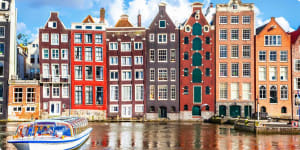
- Return To Top
- Tour Details
Related Articles
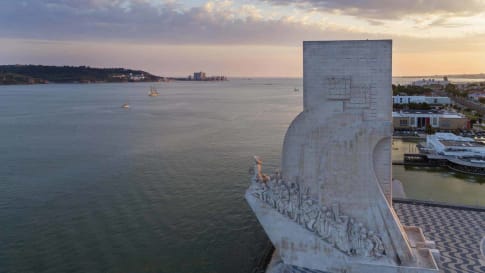
'Queen of the Sea': Lisbon: The Definitive Guide for Travellers
‘Queen of the Sea’: A History of Lisbon In 1554, the writer Damião de Góis claimed that out of all the European cities, only Lisbon and her rival Seville ‘could rightfully be called Ladies and…
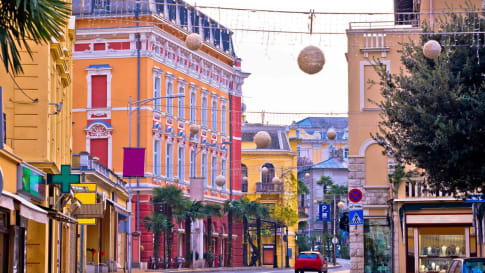
A history of medieval Croatia: The Definitive Guide
The ‘unfaithful Croats’: A history of medieval Croatia. When you think of Croatia, what comes to mind? For many travellers it’s a series of vivid colours: the blue of the Adriatic, the yellow beaches of…
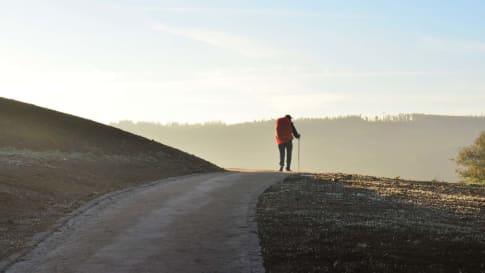
Ancient Routes, Fresh Eyes: European Pilgrimage Routes for the Modern Traveller
Ancient Routes, Fresh Eyes: Nine European Pilgrimage Routes for the Modern Traveller The word ‘pilgrimage’ or ‘pilgrim’ comes from the Modern French word pèlerin, which means ‘foreigner, stranger’, highlighting the concept that the faithful is not of…
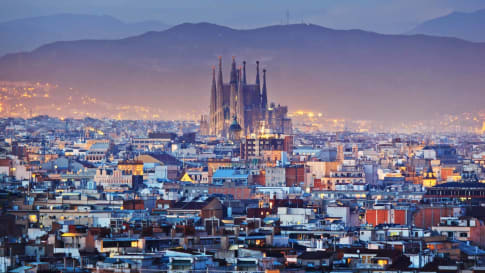
Barcelona Travel Notes
Barcelona is one of the cultural highlights of Europe. Situated on the Mediterranean coast of the Iberian Peninsula, the Catalan capital is famous for its distinctive architecture and its world-renowned food and wine.
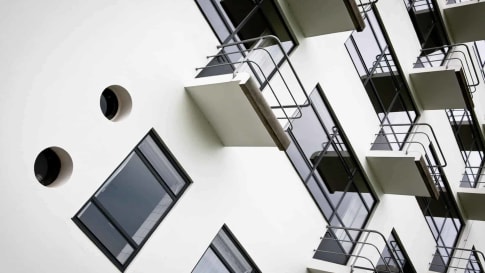
Bauhaus Movement: The Definitive Guide for Travellers
The Bauhaus School and its 100-Year Legacy The Bauhaus School was the brainchild of Walter Gropius of Germany, who reimagined art and utility as a single form that combined architecture, fine arts, and crafts (MET…
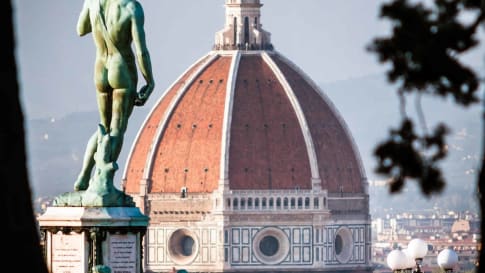
Brunelleschi's Dome: The Amateur turned Renaissance Genius
Filippo Brunelleschi. We will look at who he was and how he came to win the competition to design the dome for Florence's cathedral.
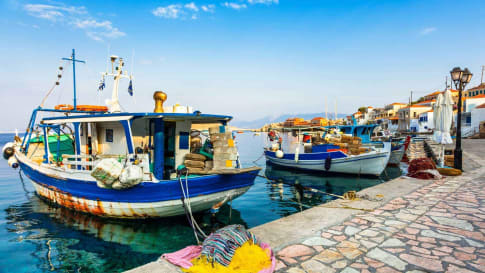
Empires Crossing the Mediterranean: 1130-1300
As a sea connecting continents and stretching from the Atlantic Ocean in the west to Asia in the east, the Mediterranean has for centuries been a centre of trade and exploration.
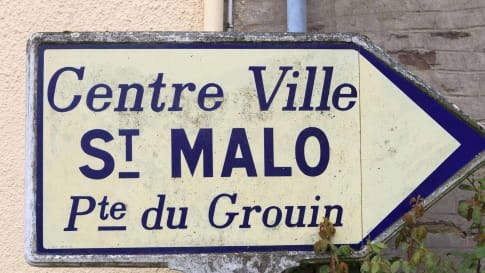
Exploring France's Saint-Malo
Article about a personal view on St Malo for mature and senior couple and solo travellers exploring Mont st Michel France and Europe. Interest in history , landscapes and cities as well as places with great art such as Rodin and the impressionists such as Monet .

Related Tour Categories
History in-depth.
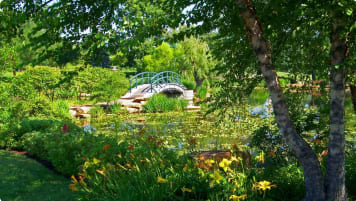
Level 2 - Moderate
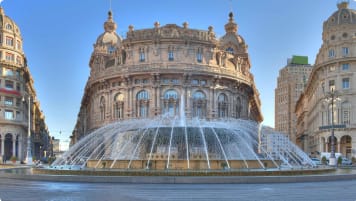
Join 22,383 like-minded travellers receiving our weekly newsletter.
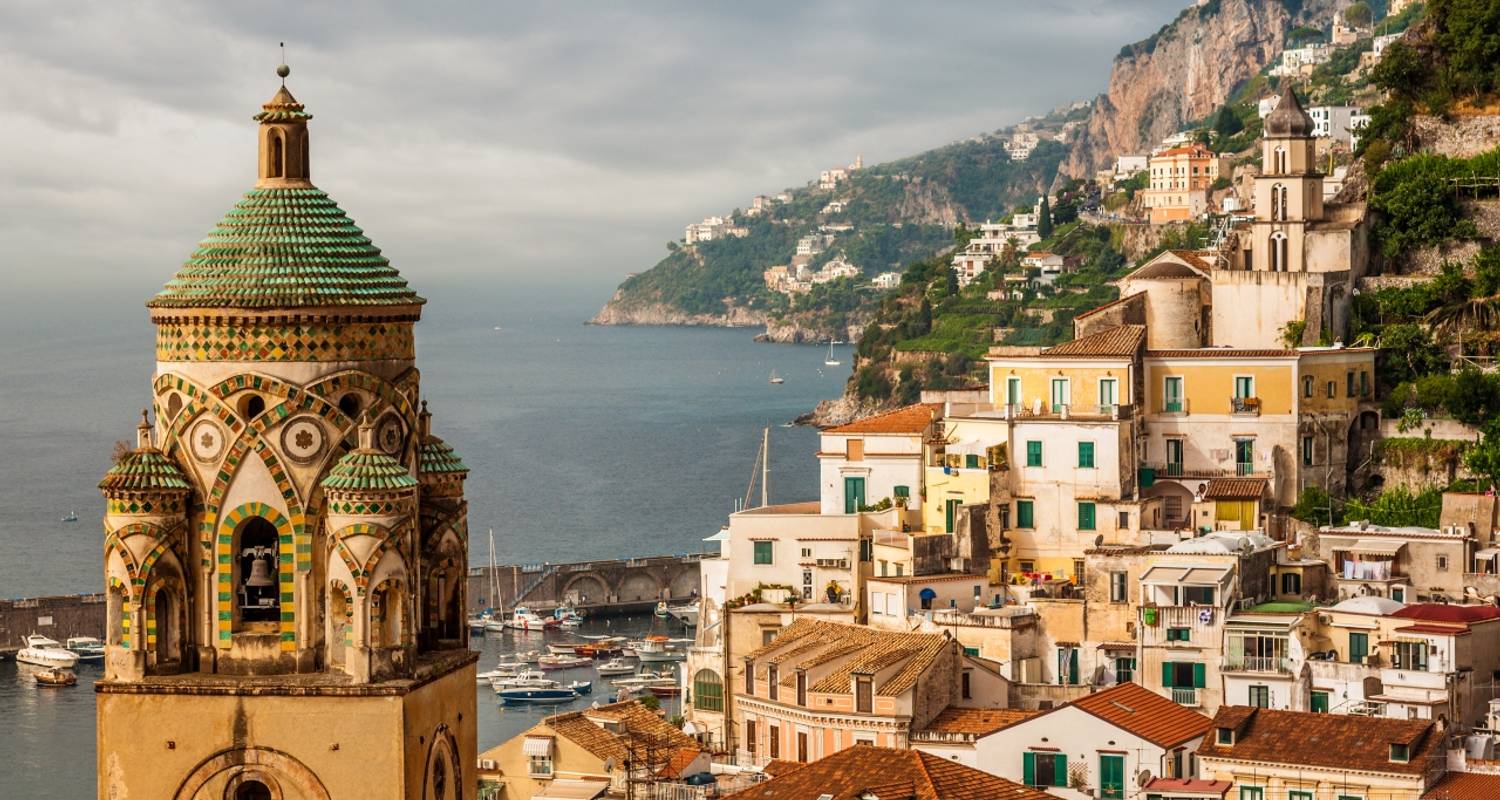
Western Europe Tours for Seniors
- Choose from 3,400+ Western Europe tours
- 57,500+ verified reviews from TourRadar travelers
- 24/7 customer support
10 best trips for 'over 50s' in Western Europe
Compiled by

Melissa Western Europe travel expert at TourRadar
Europe Escape
European highlights, european whirl (summer, end paris, 12 days), european cavalcade (end paris, 18 days), european whirl (winter, end paris, 12 days), eco-comfort - tour of italy by train, europe's highlights, seven countries, venice & paris with london, discovering the best of portugal, 10-day ultimate ireland small group tour.
“We are already planning our next one in 2025. I look forward to use your tour services next year.” Marisol Giles, traveled in August 2024
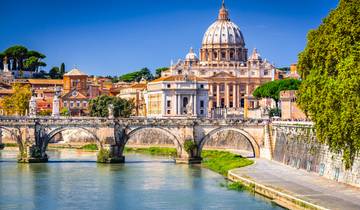
- In-depth Cultural
- Coach / Bus
- Sightseeing
- Snap photos at the iconic Leaning Tower of Pisa
- Visit Burgundy, Florence, Innsbruck, Munich and Ghent
- Enjoy free days in Rome, Paris, and the Swiss Alps
“Met new people and all the places were unique. Got to rest in the bus while travelling which is what enabled me and my wife to recover and stay afresh.” Sai kiran Linga, traveled in April 2024
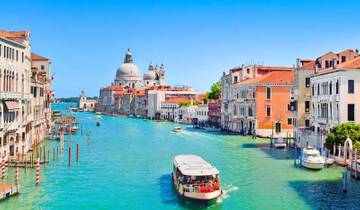
- Taste some delicious Dutch cheese and Belgian waffles
- Enjoy traditional Bavarian beer and delicious Tuscan wine
- See the Leaning Tower of Pisa and tour the ancient Rome
“The European wirl was amazing. It was my trip of a lifetime.” Zoran Stamenkobic, traveled in June 2023

- Cruise the Rhine from Boppard to St. Goar
- Tour Rome's ancient sites and Vatican City
- Explore Munich and cross into Innsbruck
“Awesome trip, travel director great fun and very knowledgeable, would definitely use again.” Carla Shields, traveled in April 2024
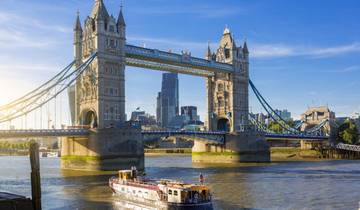
- Christmas & New Year
- Explore Amsterdam by bike or boat
- Enjoy the views from the Eiffel Tower
- Walk through Lucerne's historic Old Town
“From the romantic streets of Paris to the historic allure of Rome, we covered all of the iconic sights.” Robert Charles, traveled in November 2023
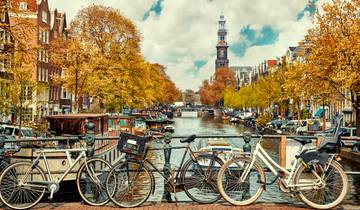
- Tour Rome's ancient icons and Vatican City
- Ride the Eurostar to Brussels and coach to Amsterdam
“The Tuscany tour was a highlight, blending history, culture, and delightful cuisine superbly.” Stephanie, traveled in June 2022
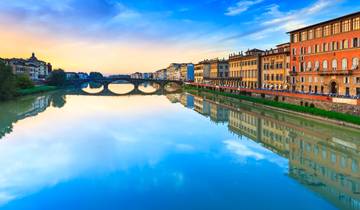
- Train & Rail
- Explore St. Mark's Basilica and Doge's Palace
- Taste Chianti wines in a Tuscan vineyard
- Skip lines at the Vatican and Sistine Chapel
“Communication was clear and informative.” Leanne, traveled in June 2023
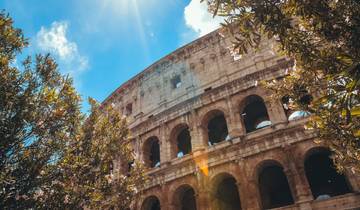
- See Neuschwanstein Castle in Germany
- Take a boat to St. Mark's Square, Venice
- Tour St. Francis Basilicas in Assisi
“The tour was amazing. I would definitely use Cosmos again.” BERNETTA, traveled in May 2023
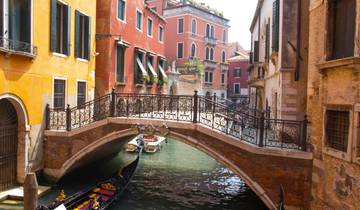
- Enjoy a boat ride to Venice's Piazza San Marco
- Discover Parisian sites on a guided tour
- Explore London's iconic landmarks
“The handpicked hotels were cozy retreats, offering comfort and a genuine taste of local hospitality.” Christine, traveled in October 2023

- Explore Porto and cruise the Six Bridges
- Visit Tomar's Convento de Cristo and Óbidos
- Tour medieval Braga and Guimarães
“Outstanding. Seamus is the Bomb!!!” Lindia Hough, traveled in September 2024

- Enjoy Bohemian Galway and venture to the ancient Aran Islands
- Learn about the history of the Troubles in Derry and Belfast
- Kayak with dolphins and Explore the mighty Cliffs of Moher
More about Western Europe
Discover TourRadar

IMAGES
VIDEO
COMMENTS
See the best tours & trips for seniors in Europe. Join other 50 plus travelers while exploring places like Vienna and Budapest. Choose from 4943 trips with 73554 customer reviews.
From our Basix style with simple accommodation and plenty of free time to our Premium trips featuring our best stays, experiences and leaders (with our Original and Comfort styles in between), there's something to suit every Intrepid traveller.
Uncover the secrets of London, Rome, Florence, and Paris as you visit historic landmarks like St. Peter’s Basilica and experience the allure of the Eiffel Tower and Notre Dame Cathedral. Next, explore the enchanting cities of Amsterdam, Heidelberg, Munich, Innsbruck, Venice, and Lucerne.
Join Odyssey on meticulously crafted European tours, which cater to seniors seeking to explore walking trails like the Camino de Santiago and other pilgrim routes.
Escorted 65 day Grand tour of Europe for mature and Senior travellers. Explore, Germany, Austria Italy, France and more. Call to book today
See the best tours & trips for seniors in Western Europe. Join other 50 plus travelers while exploring places like Rome and Amsterdam. Choose from 3411 trips with 57646 customer reviews.